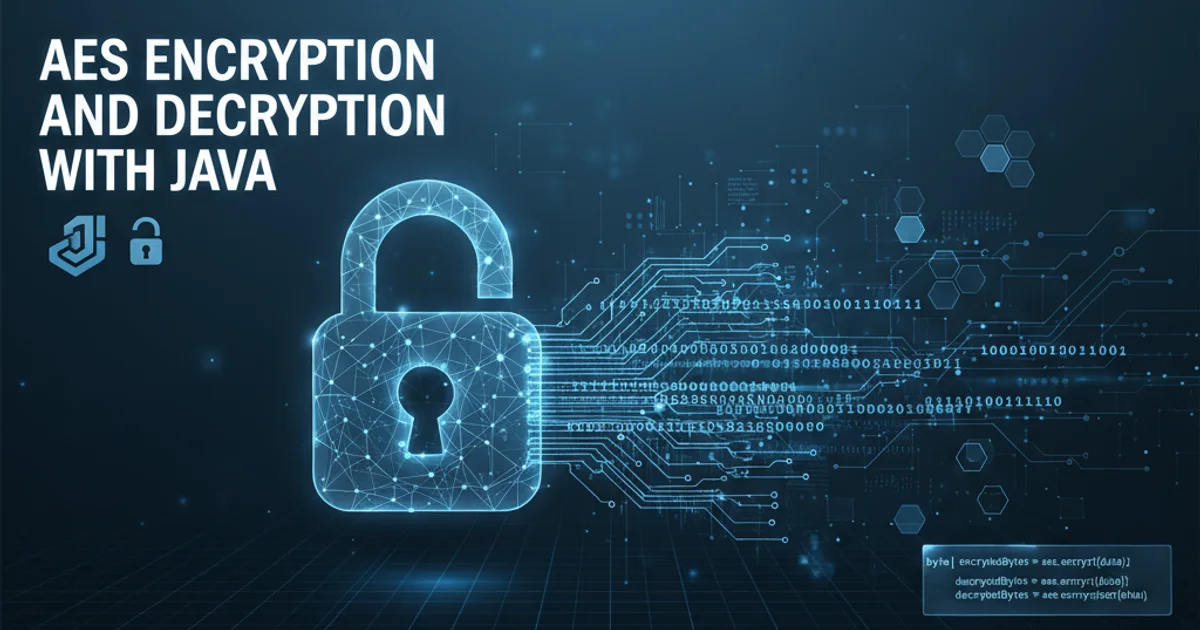AES Encryption and Decryption with Java
Categories:
AES Encryption and Decryption in Java

Learn how to implement Advanced Encryption Standard (AES) for secure data encryption and decryption in Java, covering key generation, initialization vectors, and best practices.
The Advanced Encryption Standard (AES) is a symmetric block cipher widely used for securing sensitive data. It's a robust and efficient algorithm, adopted by governments and organizations worldwide. In Java, the javax.crypto package provides the necessary classes and interfaces to implement AES encryption and decryption. This article will guide you through the process, from generating secure keys to encrypting and decrypting data, while highlighting important security considerations.
Understanding AES Fundamentals
AES operates on fixed-size blocks of data (128 bits) using a secret key. The key length can be 128, 192, or 256 bits, with longer keys offering higher security. Symmetric encryption means the same key is used for both encryption and decryption. To enhance security and prevent identical plaintext blocks from producing identical ciphertext blocks, AES often uses an Initialization Vector (IV) in conjunction with a Cipher Mode (e.g., CBC - Cipher Block Chaining). The IV must be unique for each encryption operation but does not need to be secret; it's typically transmitted alongside the ciphertext.
flowchart TD
A[Plaintext] --> B{Key Generation}
B --> C[Secret Key]
D[Initialization Vector (IV)]
C & D --> E{AES Cipher Initialization}
E --> F[Encryption Process]
F --> G[Ciphertext + IV]
G --> H{Decryption Process}
H --> I[Decrypted Plaintext]AES Encryption and Decryption Flow
Key Generation and Management
The security of AES heavily relies on the secrecy and strength of the encryption key. Generating a strong, random key is paramount. Java's KeyGenerator class is used for this purpose. For AES, you'll typically use KeyGenerator.getInstance("AES") and initialize it with a desired key size (e.g., 128, 192, or 256 bits). It's crucial to store and manage these keys securely, as compromise of the key means compromise of all encrypted data.
import javax.crypto.KeyGenerator;
import javax.crypto.SecretKey;
import java.security.NoSuchAlgorithmException;
public class AESKeyGenerator {
public static SecretKey generateAESKey(int keySize) throws NoSuchAlgorithmException {
KeyGenerator keyGen = KeyGenerator.getInstance("AES");
keyGen.init(keySize); // 128, 192, or 256 bits
return keyGen.generateKey();
}
public static void main(String[] args) {
try {
SecretKey aesKey = generateAESKey(256);
System.out.println("Generated AES Key (Base64 encoded): " + java.util.Base64.getEncoder().encodeToString(aesKey.getEncoded()));
} catch (NoSuchAlgorithmException e) {
e.printStackTrace();
}
}
}
Generating a 256-bit AES Secret Key
Implementing AES Encryption and Decryption
The core of AES operations in Java is the Cipher class. You initialize it with the desired algorithm, mode, and padding scheme (e.g., AES/CBC/PKCS5Padding). CBC (Cipher Block Chaining) is a common mode that requires an Initialization Vector (IV). PKCS5Padding handles cases where the plaintext length is not a multiple of the block size. The IV should be randomly generated for each encryption and stored with the ciphertext. For decryption, the same IV used during encryption must be provided.
import javax.crypto.Cipher;
import javax.crypto.KeyGenerator;
import javax.crypto.SecretKey;
import javax.crypto.spec.IvParameterSpec;
import java.security.NoSuchAlgorithmException;
import java.security.SecureRandom;
import java.util.Base64;
public class AESEncryptDecrypt {
private static final String ALGORITHM = "AES/CBC/PKCS5Padding";
public static SecretKey generateAESKey(int keySize) throws NoSuchAlgorithmException {
KeyGenerator keyGen = KeyGenerator.getInstance("AES");
keyGen.init(keySize);
return keyGen.generateKey();
}
public static IvParameterSpec generateIv() {
byte[] iv = new byte[16]; // 16 bytes for AES
new SecureRandom().nextBytes(iv);
return new IvParameterSpec(iv);
}
public static String encrypt(String plaintext, SecretKey key, IvParameterSpec iv) throws Exception {
Cipher cipher = Cipher.getInstance(ALGORITHM);
cipher.init(Cipher.ENCRYPT_MODE, key, iv);
byte[] cipherText = cipher.doFinal(plaintext.getBytes());
return Base64.getEncoder().encodeToString(cipherText);
}
public static String decrypt(String ciphertext, SecretKey key, IvParameterSpec iv) throws Exception {
Cipher cipher = Cipher.getInstance(ALGORITHM);
cipher.init(Cipher.DECRYPT_MODE, key, iv);
byte[] plainText = cipher.doFinal(Base64.getDecoder().decode(ciphertext));
return new String(plainText);
}
public static void main(String[] args) {
try {
SecretKey key = generateAESKey(256);
IvParameterSpec iv = generateIv();
String originalText = "This is a secret message that needs to be encrypted.";
System.out.println("Original Text: " + originalText);
String encryptedText = encrypt(originalText, key, iv);
System.out.println("Encrypted Text: " + encryptedText);
System.out.println("IV (Base64 encoded): " + Base64.getEncoder().encodeToString(iv.getIV()));
// In a real scenario, you would store/transmit the IV along with the encrypted text
// For decryption, you'd retrieve the key and the IV.
String decryptedText = decrypt(encryptedText, key, iv);
System.out.println("Decrypted Text: " + decryptedText);
} catch (Exception e) {
e.printStackTrace();
}
}
}
Complete AES Encryption and Decryption Example
java.security.SecureRandom) for generating IVs and keys. Never reuse an IV with the same key, especially with CBC mode, as it can lead to security vulnerabilities.Best Practices and Security Considerations
Implementing encryption correctly is critical. Here are some best practices:
- Key Management: Securely store and manage your encryption keys. Avoid hardcoding them. Consider using Java KeyStore or external Key Management Systems.
- Initialization Vectors (IVs): Always use a unique, randomly generated IV for each encryption operation. The IV does not need to be secret but must be transmitted or stored alongside the ciphertext.
- Cipher Modes and Padding: CBC with PKCS5Padding is a common and generally secure choice. Be aware of other modes like GCM (Galois/Counter Mode) which provides authenticated encryption (integrity and authenticity in addition to confidentiality).
- Error Handling: Implement robust error handling for cryptographic operations. Exceptions like
BadPaddingExceptioncan indicate tampering or incorrect keys/IVs. - Algorithm Updates: Stay informed about cryptographic best practices and potential vulnerabilities. Periodically review and update your encryption algorithms and key sizes if necessary.
- Data Integrity: For critical applications, consider adding a Message Authentication Code (MAC) or using authenticated encryption modes like AES/GCM to ensure data integrity and authenticity, preventing tampering.